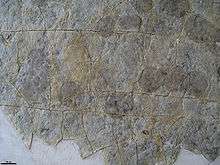Epibaion
| Epibaion Temporal range: Ediacaran, around 558–555 Ma | |
|---|---|
| Trace fossil classification | |
| Ichnogenus: | †Epibaion Ivantsov, 2002 |
| Ichnospecies | |
| |

Epibaion waggoneris, chain of trace platforms and the imprint of the body of Yorgia waggoneri (right), which created these traces.
Epibaion is a trace fossil imprint of the Ediacaran animals of the phylum Proarticulata, which became extinct in the Precambrian. Imprints often occurring in chains, that is interpreted as a feeding trace; some chains terminate in a body fossil, allowing their maker to be identified. Several specimens are known; E. waggoneris was produced by Yorgia waggoneri; E. costatus by Dickinsonia costata, and E. axiferus, the type species, has as yet not been found with a trace-maker. It is proposed that the Australian fossil Phyllozoon is also a feeding trace of Proarticulata.[1][2][3]
See also
References
- ↑ Ivantsov, A.Y.; Malakhovskaya, Y.E. (2002). "Giant Traces of Vendian Animals" (PDF). Doklady Earth Sciences. 385 (6): 618–622.
- ↑ Ivantsov, A. Y. (2011). "Feeding traces of Proarticulata — the Vendian metazoa". Paleontological Journal. 45 (3): 237–248. doi:10.1134/S0031030111030063.
- ↑ Andrey Yu. Ivantsov (2013). "Trace Fossils of Precambrian Metazoans "Vendobionta" and "Mollusks"". Stratigraphy and Geological Correlation. 21 (3): 252–264. doi:10.1134/S0869593813030039.
This article is issued from Wikipedia - version of the 6/29/2016. The text is available under the Creative Commons Attribution/Share Alike but additional terms may apply for the media files.